Knowing THIS Will Help Your Balance (And Prevent Falls!)
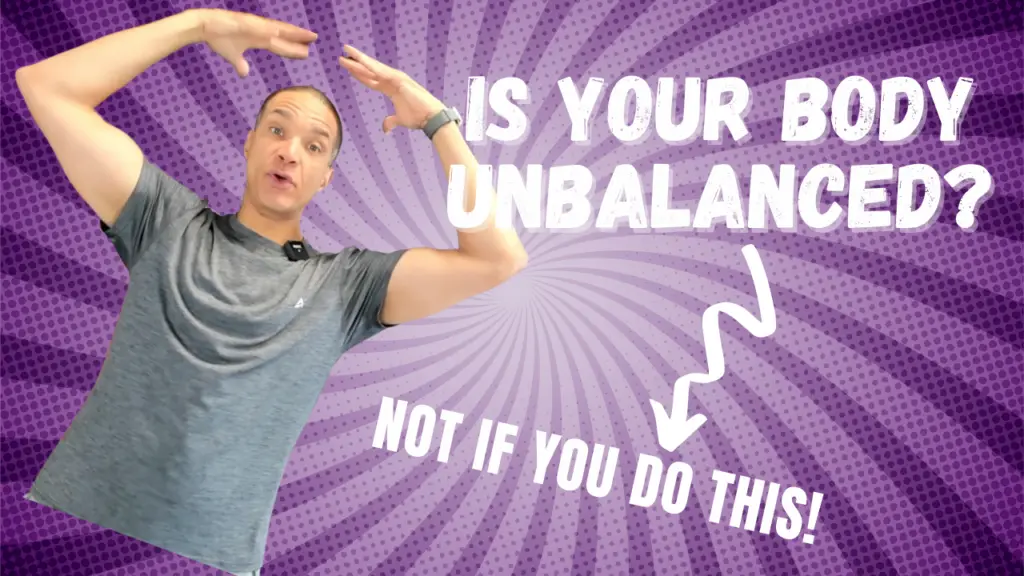
Click on the image to watch the video
Feeling off-balance or constantly afraid you’ll fall is more than a worry. It impacts your life, holding you back from activities you want to do and sapping your confidence. Many balance programs focus on standing on one foot or doing random balance drills, but true stability is much more complex, and so is the path to improving it.
Why Most Balance Routines Fail and What Actually Works
Cookie-cutter approaches to balance just aren’t enough. They’re too general, ignoring the layered complexity and uniqueness of every body. To truly improve your balance, you need a holistic plan that addresses your structure, your “soft tissue” (muscles, ligaments, fascia), and your neurological “computers”—your proprioceptors.
1. Structural Alignment Your Foundation
Imagine your body as a house. If the foundation or walls are off, everything above is unstable. Your bones must be aligned, and your hips and pelvis balanced, to channel force smoothly through your entire frame. This is more than posture—it’s about the interplay of hard (bone) and soft tissue (muscles, fascia, ligaments) all working together for stable movement.
Fun fact: Your bones adapt to repeated forces and movement—if you’re off balance or compensating, your skeleton will actually remodel around those forces, making misalignment worse over time. That’s why generic “adjustments” alone never last; your muscles and fascia must be trained, too.
2. Biotensegrity The Body’s Inner Suspension Bridge
Ever heard of “tensegrity”? It just means the harmony between tension and compression—how your soft tissue web, not just bones, is what actually keeps you upright and balanced. Your muscles, tendons, ligaments, and fascia are all interconnected and play a major role in stability, not just movement.
If you’re missing strength or mobility in one area, the whole system suffers. Generic exercise routines or bouncing between fad workouts without addressing your personal gaps won’t help. The key is specificity—testing and building up your weak links.
3. The Glute Medius Your Hip’s Hidden Hero
Your glute medius stabilizes the pelvis and is foundational for staying upright, stepping, and shifting your weight. If it’s weak or poorly coordinated, your “house” tips and daily movements become risky. The best assessment and strengthening moves isolate different fibers in the glute medius (not just doing “clamshells”), with your leg in various angles and a strong, fixed core for real-world benefit.
4. Proprioception Training Your Balance “Computers”
Balance isn’t just muscle—it’s knowing where your body is in space, thanks to proprioceptors (“position sensors”) in your feet, spine, TMJ, eyes, and ears. If one system’s off, your brain’s internal map is wrong—you feel “off” even when you look straight, and compensations leak through the whole body.
To improve this, you need:
- Targeted foot and ankle work: barefoot balance, one-leg stances, standing on soft surfaces
- Spine awareness: core and trunk engagement, rotational exercises
- Head, jaw, eye, and ear alignment: gentle neck exercises, gaze stability drills
Proprioceptive training should progress from simple (e.g., static one-leg balance) to complex (eyes closed, dynamic reaches, unstable surfaces, dual-tasking). Key: Always train specifically for your deficits—not just generic drills.
5. Start Where YOU Are
You can’t address everything at once—successful balance training means finding your lowest-hanging fruit. Use a notepad, test your strengths and weaknesses, and focus on two or three new habits or drills at a time.
If you want a body that’s truly balanced and ready for life—whether that’s hiking, gardening, or just moving with confidence and without fear of falling—you need to address all the interconnected parts: structure, soft tissue, proprioception.
[Book a free consult] for a holistic assessment and personalized program that will target exactly what you need to regain control, improve your balance, and enjoy every activity with confidence.
it’s not just working out, it’s building a foundation for a better life.
Find out more @
Working Out FOR a BETTER Life: It’s About the Foundation, Not Just Fitness

It’s not just working out—it’s building a foundation for a better life. That’s not just a slogan. It’s the driving insight behind what a true health and fitness routine is supposed to achieve. When approached holistically, fitness is the gateway for transformation: physically, mentally, emotionally, and even spiritually.
My Journey to Holistic Fitness
I’ve felt this in my bones since I was young—even before I had the words. Sports, movement, and healthy eating gave me structure and focus growing up, and I soon realized the value of incorporating mindset, visualization, and positive belief alongside physical training. What began just as sports and healthy eating soon became routines in goal setting, journaling, and affirmations. These simple but powerful strategies enabled me to go beyond what teachers or diagnoses thought possible—and most importantly, to start believing in my own potential.
You’re More Than a Body. Fitness Should Reflect That.
As I grew and eventually became the owner of SolCore Fitness, I kept seeing the same problem: too many programs—especially in big-box gyms—treat exercise like a checklist. Do these reps, burn these calories, and move on. But a fitness foundation built only on the latest routine, without guidance or purpose, can’t address the depth of who you are or the layered challenges you face.
A holistic fitness plan must consider:
- Physical Health: Building strength, mobility, and injury resistance so you can move, play, and age well.
- Mental Health: The right routine improves focus, battles distraction, calms a busy mind, and boosts creativity and resilience.
- Emotional Wellbeing: True fitness reduces stress, increases confidence, and helps you bounce back from setbacks.
- Social Connection & Purpose: Working out becomes a vehicle for belonging, accountability, and compassion—for yourself and others.
- Spiritual Health: Movement connects you to what matters—whether it’s a sense of purpose, gratitude, or something greater than yourself.
True Holistic Fitness Builds on Strong, Integrated Foundations
Every phase of your life brings new challenges, losses, and opportunities. Sometimes you might feel invincible; other times, a single injury or setback can shake your identity to its core. I know this firsthand—after a significant injury, I had to rethink everything. Gone were the routines that used to work. In their place, I found osteopathy and the “structure dictates function” principle. I became obsessed with weaving together strength, nutrition, movement, mindset, and deeper learning.
When you combine physical, mental, and emotional progress, transformation happens:
- You learn to appreciate what your body CAN do (not just what it looks like)
- You wake up parts of yourself—muscle chains, mental habits, creativity—that had “fallen asleep”
- You discover new reserves of resilience and motivation, even when you “fail” or meet resistance
Most importantly, you realize: Every challenge is an opportunity to know yourself more deeply, and every victory unlocks another level of growth.
It’s Not “Just” About Longevity—It’s About Quality and Purpose
We all want to live as long as possible, but what about living vibrantly and joyfully, every step of the way? A holistic fitness program is about creating that positive trajectory, so you can:
- Stay active and pain-free through every decade
- Play with kids, grandkids (or great-grandkids!)
- Try new activities, travel, garden, or pursue passion projects
- Feel mentally clear, socially connected, and emotionally grounded—even when times get tough
A complete, individualized fitness plan helps YOU decide what kind of life you want to live…and then gives you the tools (and the confidence) to achieve it.
[Book a free consult] if you’re ready to discover what a true holistic health and fitness plan can do—not just for your muscles, but for your entire life journey. Let’s build the foundation that keeps you strong, joyful, and inspired for decades to come.
it’s not just working out, it’s building a foundation for a better life.
Find out more @
Leg Length Discrepancy DO You Have It? WHY It Matters. WHAT To Do.
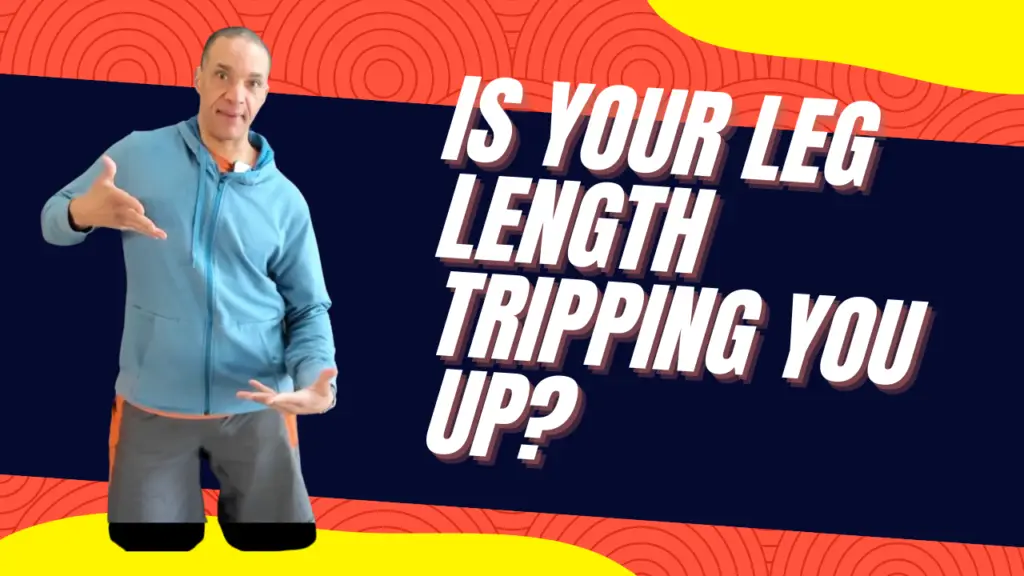
Ever feel like your body is off-balance one hip higher, your shoes wear unevenly, or odd aches pop up in your knees, hips, or back? If so, you might have a leg length discrepancy and yes, it matters more than you think. This issue can have a direct impact on movement, posture, and discomfort throughout your body.
[The Ultimate Guide For A Holistic Exercises And Fitness Program]
Why Does Leg Length Discrepancy Matter?
When one leg is longer or shorter than the other—even by a small margin—it can throw your whole body out of balance. This can create issues wherever your body is weakest: hips, knees, feet, spine, or even in your digestion or thinking (thanks to nervous system compensation). Research estimates that 90% of people have some difference, but most are mild. About 20% of adults have a difference above 9mm (about 3/4 inch), which is significant enough to need support.
True vs. Functional Leg Length Discrepancy
- True Discrepancy: One leg bone is physically shorter or longer, due to genetics, injuries, or surgeries (congenital, trauma, or after hip replacements).
- Functional (Apparent) Discrepancy: The legs are structurally equal, but soft tissue, joint misalignments (like in your SI joint), or muscle imbalances make one leg “act” shorter. This is far more common, and easily misdiagnosed.
How Do You Know Which Kind You Have?
- True: Only confirmed by measurements between bony landmarks (greater trochanter to lateral knee, or by X-ray).
- Functional: May appear shorter/longer with some measurements, but really reflect pelvis, SI joint, or muscle tightness.
What Causes Leg Length Discrepancy?
- Congenital structural differences (from birth)
- Traumas/fractures or damage to growth plates (especially in childhood)
- Hip or knee replacements, bone infections, tumors
- Muscle or ligament tightness (especially hip rotator cuff, SI joint imbalance)
How Much Is Too Much?
Small differences (<10mm or 1/2 inch) rarely cause problems. Above 10mm, you’ll likely feel symptoms—back/hip/knee pain, uneven wear on shoes, or even poor posture and gait changes. Significant differences may require lifts, physical therapy, or, rarely, surgery.
What Should You Do?
1. Test & Measure
· Compare both bone length (greater trochanter to ankle; not just ASIS-to-malleolus, due to joint effects).
· Assess for SI joint or pelvic involvement: Often, a rotated or flared pelvis mimics a true discrepancy. Address this with appropriate therapy, not just a heel lift.
2. Address Functional Discrepancies First
· Target soft tissue and muscle imbalances, especially pelvic muscles and deep rotators (obturators, gemelli, piriformis, quadratus femoris).
· Stretch AND strengthen—each muscle may need a different “counteraction” exercise. Check both sides to keep your pelvis balanced.
· Avoid using heel lifts for purely functional causes, as they can reinforce imbalance.
3. Stretching & Mobility Work
· Find which stretches are hardest for you—those are probably your critical areas.
· Don’t just focus on the “short” side—balance both.
4. Know When to Involve a Specialist
If you truly have a bone length difference >1/2 inch and symptoms persist, a skilled therapist or ortho can guide treatment, which may involve lifts, therapy, or rarely surgery.
Key Takeaway
Don’t assume all leg length differences need a “fix.” Find out whether yours is structural or functional, treat what you can, and always address muscle and joint imbalances alongside any other interventions. Your entire body from head to toe will thank you.
it’s not just working out, it’s building a foundation for a better life.
Find out more @
Osteoporosis AND Bending Over: What’s Safe, What’s Not, and How to Move Better

If you’ve been diagnosed with osteoporosis, chances are you’ve heard some version of this warning: “Don’t bend over you might break your back!” But is it really that simple? What if you drop something, need to garden or vacuum, or want to play with your grandkids? Does having osteoporosis mean you’re forever doomed to a life of restricted movement or is there a more balanced, empowering approach?
[The Ultimate Guide For A Holistic Exercises And Fitness Program]
The Standard Warning and Why It Exists
Osteoporosis thins your bones and makes them more fragile, especially at the spine. Standard advice is to avoid:
- Forward flexion (bending at the waist with a rounded back)
- Twisting (especially while flexed)
- Lifting heavy items with poor body mechanics
The reason is simple: These moves sharply increase compressive forces on your spine, particularly the front part of your vertebral bodies, and this is exactly where bone is most fragile with osteoporosis. In fact, statistics show the majority of osteoporosis-related spinal fractures happen with simple, daily movements—not from falls or accidents. Even something as simple as bending to tie your shoes or pick up a pet can trigger a vertebral fracture if your posture is poor and your bones are weak.
Why This Advice Isn’t the Whole Story
But real life isn’t lived in a bubble. You WILL need to bend, reach, and twist from time to time. And here’s the truth: No two people with osteoporosis are exactly alike. Your risk of fracture is determined by far more than just your diagnosis. It’s about your overall bone density (as measured by your T-score), your history of fractures (or lack thereof), your balance and strength levels, your soft tissue health, your nutrition, and even your hydration and stress levels.
Did you know…?
- A T-score from −1 to −2.5 is considered osteopenia (lower than average bone mass but not yet true osteoporosis).
- Osteoporosis is diagnosed at −2.5 or below, and deeper negatives signal greater risk.
- If you have had a previous spinal fracture, your risk of another is much higher.
What About Everyday Life?
Imagine you have beginning osteoporosis or osteopenia. You still want to hike, garden, travel, and play with your grandkids. Should you be terrified to bend? No! But should you move with greater awareness and make smart modifications? Absolutely.
Let’s break down the top considerations:
- Your Bone Density and History
If your osteoporosis is advanced (lower T-score and/or history of spinal fractures), you must be extra cautious—especially with high-risk, forceful, or repetitive bends. If you’re earlier in the process and otherwise active, movement is critical for maintaining bone and muscle! - Your Current Fitness and Mobility
How balanced and strong is your body right now? If you have good posture, strong legs and hips, and flexible fascia, you’re already more resilient. If you’re already a little frail, dehydrated, or consistently out of alignment, your risk is higher—and so your plan needs to start with foundations. - Your Technique: Bending Smart
The key for everyone—regardless of bone density—is learning and practicing safe movement patterns: - Hip hinge, not spine curl: Bend at the hips and knees, sticking your chest out, so your back stays straight and the force is safely absorbed in your larger stabilizer muscles.
- Keep movement slow and controlled: No quick, abrupt bends. Avoid bouncing or twisting motions.
- Keep weight close to your body: Don’t reach, stretch, and twist while holding something heavy or awkward.
- The Power of Whole-Body Training
Here’s what’s often missing from most online advice: Total body balance, hydration, fascia health, and postural training are all crucial. Balance helps prevent falls. Hydration and soft tissue health support bone health, nutrient delivery, and safe movement. - Training for balance and stability protects you from both falls and spinal stress.
- Maintaining your four spinal curves and strengthening your deep core (abs, back, and trunk muscles) disperses forces more safely.
- Hydration supports disc “fluffiness” and joint health—reducing spinal compression and painful movements.
- You CAN Build (or Re-Build) Bone Strength Safely!
Safe weight-bearing, resistance, and low-impact exercises (like walking, light resistance, Nordic walking, and gentle yoga—avoiding loaded flexion and twisting) stimulate new bone growth, help you maintain muscle, and boost confidence. - Every Program Must Be Personal
Your daily routine, goals (hiking, playing, gardening, or just remaining independent), nutrition, supplement needs, and even sleep and stress must be considered together—not just one-size-fits-all rules. If you’re deeper into osteoporosis, all activity should be customized, and for some people, only micro-movements and balance work are appropriate.
Practical “Yes/No” for Bending Over With Osteoporosis
- Beginning osteopenia, active & balanced: Yes—with good technique, body awareness, and gradual progression.
- Moderate osteoporosis, no previous fractures, working on fitness & nutrition: Cautious yes, with modifications and under expert supervision.
- Advanced osteoporosis with previous fractures or other serious risk factors: Very limited—avoid flexion, get expert advice, focus on postural and functional strength, microstimulation, and sustainable movement patterns.
Never try to “push through” pain, round your back under load, or perform high-impact, jerky, or twisting exercises without guidance.
The Bottom Line
Bending over with osteoporosis is NOT an all-or-nothing rule. It’s a nuanced, highly individual decision, and it’s about good technique, foundational strength, and building your resilience over time. Most importantly, it’s about creating balance—throughout your day, your body, and your routine. With the right plan, support, and progression, you can stay strong, independent, and active for life.
it’s not just working out, it’s building a foundation for a better life.
Find out more @
March 17, 2022 Recorded live Q & A
How to Tell if It’s Low Back, SI Joint, or Hip Pain
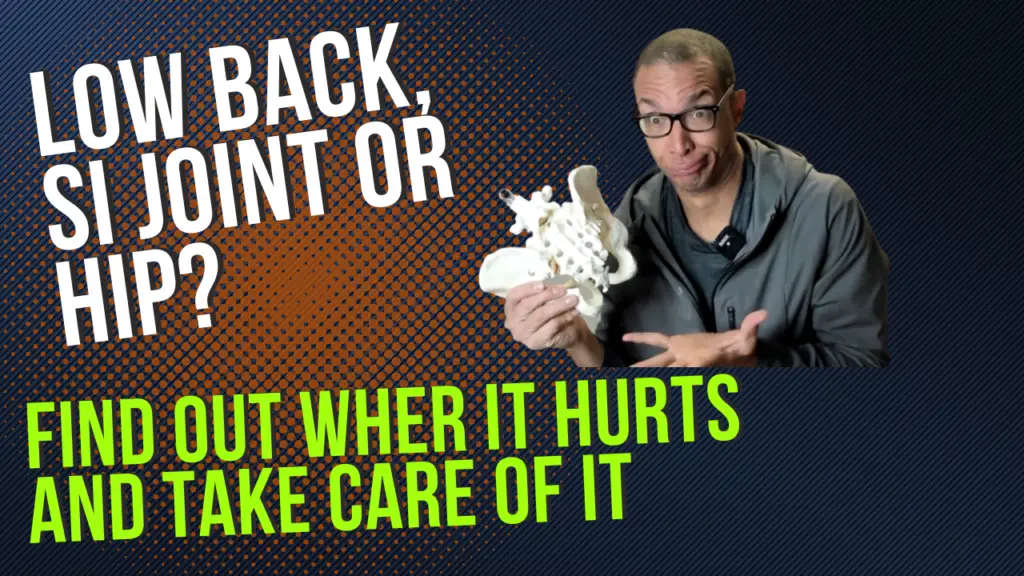
Click on the image to watch the full video
Ever feel a nagging ache, sharp jolt, or deep stiffness somewhere around your lower back, hip, or pelvis—but can’t tell exactly where it’s coming from? You’re not alone. These areas are interconnected and can easily “refer” pain to each other. Pinpointing the true source is key—since the wrong approach may not only fail to solve your pain, but actually make it worse.
Why Accurate Diagnosis Matters
Each area low back, SI joint, hip has its own causes, pain patterns, and best next steps. Back pain can show up from disc/herniation, strained ligaments, facet joints, or nerve compression, often signaled by pain with bending, twisting, or sitting. SI joint issues cause sharp or aching pain at the dimples above your buttocks, sometimes radiating to the hip or thigh, usually worse with transitions like standing, stairs, or getting up from a chair. Hip pain tends to show deep, achy, or sharp pain in the groin, outer hip, or buttock, and is aggravated by walking, weight bearing, or rotating the leg.
[OMT: Osteopathic Manual Therapy]
Where Does Your Pain Fit?
- Low Back: Pain between lower ribs and pelvis, worse with bending/lifting, may radiate down into the buttocks or leg (sciatica).
- SI Joint: Achy, stabbing pain at the upper buttock “dimples,” worse with sitting, stairs, standing from a chair, or rolling in bed.
- Hip: Deep, aching or sharp pain in front of the groin, outer hip, or buttock, worse walking or rotating the leg, or standing up.
Because these tissues share nerves and muscle attachments, problems frequently overlap. SI joint instability can create tension and pain in both the low back and hip, and vice versa.
What to Do Next
- Get Assessed Holistically: A great intake includes physical tests, history, movement screening, posture, past injuries, and lifestyle.
- Prioritize Mobility and Balance: Include corrective exercises for the suspected culprit, but address every link in the chain—muscles, joints, connective tissue, and posture.
- Integrate Injury Prevention: Pain in these regions can lead to compensation injuries, so proactive balance, core work, and muscle activation are essential.
- Choose the Right Help: If your symptoms persist, get help from a pro who specializes in holistic, functional movement (not just isolated fixes).
Takeaway:
The right approach starts with locating your pain and understanding your personal pattern. With clear information and targeted training, you can restore efficient movement without setbacks or guesswork.
it’s not just working out, it’s building a foundation for a better life.
Find out more @
Neck Pain After Sleeping: 4 Reasons Why and What To Do About It

Click on the image to watch the video
Did you wake up this morning with a stiff neck—the kind where you can’t look over your shoulder or tilt your head comfortably? Neck pain after sleeping is extremely common, with several possible causes and, thankfully, multiple ways to address and prevent it.
- Underlying Trauma
A history of trauma, like whiplash or a sports injury, can leave tissues tight, tender, or misaligned for years. Sometimes, the pain only shows up after sleeping when the body relaxes, cools down, and habitual tension “sets” into bad alignment. Not addressing acute issues right away can make future correction more difficult. Early, targeted mobility training and corrective exercise are key—even if the pain doesn’t seem urgent at first. - Postural or Overuse Strain
Desk work, smartphone use, and “tech neck” (forward head posture) retrain the body into poor alignment and chronic muscle tension. If you spend 8+ hours daily hunched forward, but only do an hour of corrective work (at best), the imbalance accumulates. This commonly leads to stiffness and pain after sleeping, when tissues contract and “remember” their imbalances. Address this by restoring shoulder, mid-back, and neck alignment; balance technology habits with posture- and flexibility-focused routines. - Pathology
Conditions like cervical radiculopathy, stenosis, or arthritis can all manifest overnight or in the morning as nerve signaling and disc pressures change with position. Persistent or worsening pain—especially with numbness, tingling, or weakness—deserves prompt professional assessment and a customized plan. - Sleep Position, Pillow, and Recovery
A poor sleep setup (too many pillows, sleeping on your stomach, or a lumpy mattress) disrupts healthy neck curves and strains muscles. Too little sleep or constant sleep interruption impairs tissue repair and healing, leading to more frequent or severe neck pain. The right pillow, good alignment, and consistent sleep hygiene are foundational for prevention.
What To Do About It
- Start with gentle mobility: Hot showers, light stretching, and slow, easy neck movements can help “wake up” the tissues.
- Consider alternating ice and heat to manage acute pain or inflammation.
- Prioritize a balanced sleep setup: Neutral head/neck alignment, supportive pillows, and sleeping on your back or side (not your stomach).
- Incorporate posture-focused, corrective, and mobility exercises throughout the day, not just after the pain sets in.
- Seek professional help for persistent, severe, or radiating pain, especially if it comes with other symptoms.
[ELDOA: The Ultimate Spine And Joint Exercises]
Don’t let neck pain after sleep become your “normal.” Discover and address the true cause, and build sustainable habits to wake up pain-free and ready for life.
it’s not just working out, it’s building a foundation for a better life.
Find out more @
How To Brace Your Core To Protect Your Lower Back!
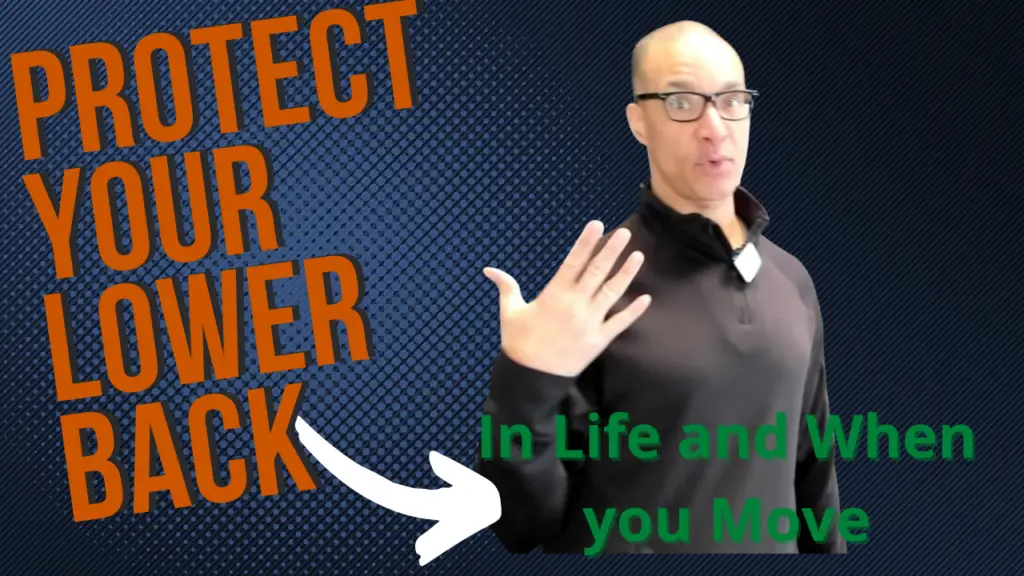
Click on the image to watch the video
Bracing the core is one of the most effective ways to stabilize and protect the lower back—during heavy lifting, dynamic movement, or simply daily tasks. But “bracing” is more than just squeezing your abs. To truly protect your spine, you need to know which core muscles matter, how to train them, and how to integrate them into all movement—not just during workouts.
What Is Core Bracing (And Why Should You Care)?
Core bracing simply means contracting all the muscles of your trunk front, sides, back, even the pelvic floor to create a “girdle” of stability around your spine. Think of how the body naturally tenses before a big exertion or if someone is about to punch you in the stomach—this helps distribute forces evenly and prevents sudden overload on any single spot in the spine.
Which Muscles Are Involved?
True bracing integrates:
- All four layers of the abdominals (rectus, obliques, transversus, internal/external)
- Deep spinal stabilizers (multifidi, transversospinalis)
- The diaphragm (breathing muscle)
- Pelvic floor
- Back muscles (erectors, lats, serratus, etc.)
These muscles must function as a coordinated system to evenly “brace” the spine—so no one link becomes the weak point.
The Keys to Smart Bracing and Injury Prevention
- Start With Deep Muscles: Deep stabilizers (like the TVA and deep back muscles) activate first to prepare the body for movement.
- Progress to Superficial Muscles: Once deep muscles are awake, train global movers like obliques and erectors in different planes—flexion, extension, rotation, lateral stability.
- The Beam Phenomenon: During squats and deadlifts, bracing helps the spine act like a strong beam—so force moves through the trunk, instead of collapsing onto the lower back.
- Don’t Overuse Bracing: You don’t need to brace every second of the day—only before higher-effort movements or when lifting, twisting, or reaching. For daily life, your core should work reflexively after proper training.
How To Learn (And Progress) Core Bracing
- Awareness: Practice “bracing for a punch” lying on your back, feeling your abs, sides, and lower back tighten in unison.
- Breathe While Braced: It’s crucial to maintain breathing—a true brace allows for expansion and natural breath, not holding.
- Segmentally Strengthen: Build up reps of basic holds, then layer in movements (squat, hinge, carry, overhead press).
- Stretch and Normalize Weak Links: Segmentally train deep stabilizers, then all layers of abs and back, then global movements.
- Integrate Into Your Life: The real win is a core that reflexively supports you during life—not one that needs constant conscious effort.
With a systematic approach—segmental strength, fascial training, posture work—bracing becomes second nature, and lower back injuries become far less likely—whether you’re working at a desk or lifting heavy in the gym.
If you want a holistic program that’s more than “just another ab workout” and addresses your needs down to the weak links, we can help. Book a [free consult] to get a custom plan for a strong, pain-free back and a core that keeps you resilient for life.
it’s not just working out, it’s building a foundation for a better life.
Find out more @
4 Steps On How Not To Get Frustrated With A Corrective Exercise Program
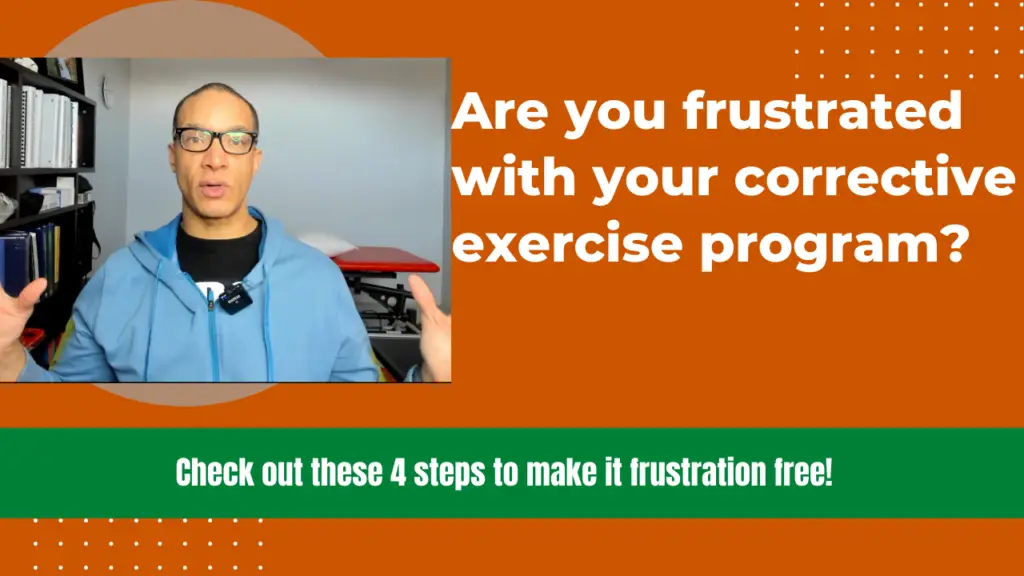
Click on the image to watch the video
Getting injured isn’t just painful it’s often maddening, especially when a corrective exercise program seems slow, confusing, or never-ending. The good news? There are concrete ways to break the cycle of frustration, so you can move forward in your recovery and come back stronger than ever.
Step 1: Get Specific and Get Curious
Most frustration comes from generic, surface-level advice—“just do X for your knee,” or “try this for your back.” But lasting results require a specific, holistic perspective. Zoom out: assess all the tissues, joints, and habits involved, not just the “squeaky wheel.” Don’t be afraid to ask more questions of your coach, read beyond the basics, or demand an individualized approach that’s tailored to the real cause of your issue—not just the symptoms.
Step 2: Stop the Comparison Game Own Your Pace
Corrective exercise takes time. Symptoms often last because underlying compensations have built up for months or years. Don’t get stuck comparing yourself to “fast healers” or internet testimonials. Accept that the process is nonlinear, and that small, focused wins build the fastest long-term progress. The less negative self-talk, the easier it gets to keep showing up and doing the right things every day.
Step 3: Expect “Productive” Discomfort Not Suffering
It’s totally normal for corrective exercises to feel challenging, awkward, or sometimes uncomfortable—especially if soft tissue is stiff, joints are sticky, or new patterns are required. But true suffering means you’re doing the wrong exercise, too much, too soon, or fighting the process. Learn to distinguish between healthy training discomfort and bad pain. Treat each session as a chance to practice patience, breathe deeply, and learn from experience—not just to “grind through.”
Step 4: Find Acceptance and Focus on What You Control
Frustration around injury often comes from wanting to skip steps or fast-forward the process. Instead, accept your current state, focus on consistent progress, and get curious about deeper aspects of health, movement, or mindset you may have previously overlooked. The more you accept and fully engage, the faster—and more lasting—your results will be. (And if you get stuck, find a trusted guide or support community.)
[Segmental Muscle Strengthening]
Corrective exercise is much more than a fix for a body part it’s a mindset and a toolkit for lifelong mobility, injury-prevention, and lasting change. Embrace the journey, adjust your expectations, and celebrate progress one step at a time.
it’s not just working out, it’s building a foundation for a better life.
Find out more @
